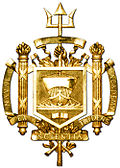| United States Naval Academy Band | |
|---|---|
 A United States Naval Academy Band musician plays a service song prior to the kick-off of a season home-opener football game, which pitted the Navy Midshipmen against Duke Blue Devils. | |
| Founded | November 1852 |
| Country | |
| Branch | |
| Garrison/HQ | United States Naval Academy |
| Nickname(s) | "The Navy's Oldest and Finest" |
| Website | www.usna.edu/USNABand/index.php |
| Commanders | |
| Director | Commander Diane Nichols |
| Senior Enlisted Leader | Master Chief Petty Officer Todd Nix |
The United States Naval Academy Band was officially founded in November 1852. Previously, there had been a band since the founding of the Naval Academy in 1845, consisting of a fifer and a drummer. The band consists of US Navy career musicians. The band is required to blend tradition and change into a wide variety of musical styles.
Contents
The Naval Academy Band is one of two Navy premier bands. The Washington DC Navy Band and the Academy Band is staffed based on auditions not limited to military personnel. Winners of the auditions are required to attend boot camp. Upon completion they are awarded the rank of E-6, Petty Officer First Class. They have been granted an exemption to wear the same uniform as a Chief Petty Officer to maintain a consistent appearance. The crest on their hats are a musician's lyre. Their career can be entirely at this one duty station. The Directors are the only officers and the only members who are subject to transfers.
The band has been termed "the Chiefs Band" by midshipmen to distinguish it from the Naval Academy Drum and Bugle Corps, which is staffed by midshipmen.
